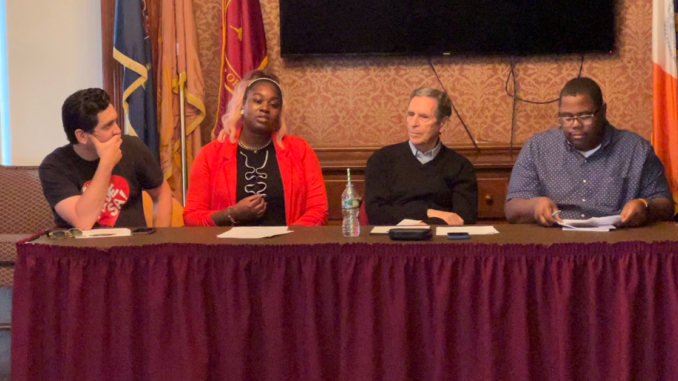
By Kate Dempsey
Advocates from the Street Homeless Advocacy Project (SHAP) visited Brooklyn College last Tuesday, Sept. 26, to begin recruiting student volunteers for its advocacy project in helping homeless New Yorkers off the streets. The project, which was greenlit last year on Aug. 11, is a partnership between Mayor Eric Adams’ administration, the Department of Homeless Services (DHS), CUNY, and other city agencies.
The partnership with CUNY includes five of its colleges to include one from each borough: College of Staten Island, Hostos Community College, York College, Hunter College, and Brooklyn College. In conceptualizing the project, founder and former executive director of the New York Civil Liberties Union (NYCLU), Norman Siegel, highlighted that the project’s goal is to focus on building a connection with the homeless people and directing them towards options for getting off of the streets.
“There are four to five thousand homeless people on the streets. We start with the premise that they don’t want to be on the streets. We don’t want them to be on the streets,” Siegel told The Vanguard. “And if we can begin to talk to them (find out who they are, why they are on the streets, do they want to be on the streets), 70% of them tell us they don’t want to be on the streets, but they don’t have viable options.”
CUNY students would be part of the first step in helping the homeless access viable options, which could include sustainable long-term living situations, mental health programs, drug treatment programs, and job training. Self-described as “neighborhood-based, New Yorker-to-New Yorker volunteer teams,” students first train with a project leader in approaching homeless people. From there, students would aim to build a connection with the homeless person and direct them to resources. Not only is the experience rewarding for the homeless person, but advocates shared that volunteers can also feel rewarded for helping the cause.
“As a person of color in America and growing up poor, you’re usually a heartbeat away from being homeless. You’re watching your parents live check to check, and you are also dealing with racism, and the idea of even having a better life just seems so far,” said Andre Donegan, a program coordinator for SHAP. “What is so special about SHAP to me is that it kind of allows me to kind of pay it forward. I was fortunate to go to school, I was fortunate enough. Even though I had parents that worked really hard, we were still poor. So for me, this is just a matter of paying it forward.”
The project stresses that this is a way for students to become agents for change, emphasizing that the social justice principle of going onto the same level as the homeless person, New Yorker to New Yorker, is a key component of the work they do. For advocates who have experienced homelessness themselves, they can pay it forward by helping those out on the streets.
“I slept on a bench […] I rode the buses all night because I was so absolutely scared to go back into a women’s shelter again,” said Danielle James, a volunteer at SHAP. “We need people like [the attendees here] to revolutionize what’s going on because the migrant system, DHS just can’t handle it. We need people to help advocate.”
The project comes after Mayor Adams’ controversial “Subway Safety Plan” enacted in February 2022 that authorizes first responders, such as police officers, to involuntarily admit homeless people into hospitals. According to the Adams administration, the move was meant to combat the increased crime happening in the subway system. The organizers of SHAP stated that while the Adams administration sponsors their program, they are opposed to Mayor Adams’ plan of involuntarily committing homeless people, and will honor any homeless person’s request to stay on the street.
“We fundamentally disagree with [Mayor Adams’] approach. We’ve been very visible and vocal in the media and on TV criticizing it and advocated for a voluntary approach rather than involuntary approach. […] And if you are going to have anyone enforce it, whether someone’s a danger to themselves or others for mental health reasons, you need either social workers or you need mental health experts or a combination of both who are more experienced and trained to make those decisions,” said Siegel.
In an op-ed opined by the New York Daily News, SHAP leaders stated that their approach “will not replace official responses to street homelessness” and that “city teams of social workers and police will continue to move people into shelters and services.” The project will focus on its advocacy support network while calling on the administration to eliminate barriers, such as shelter regulations, that stand in the way for homeless people.
According to the project, in a year of work, SHAP has helped one-third of the homeless people in NYC off the streets, predominantly in the boroughs of Manhattan and the Bronx. With the initial five colleges through the partnership with CUNY, SHAP leaders hope the project’s success will allow them to expand the project to more campuses so that even more homeless people can be reached.
“How many times have we passed by people who sit on the subway stations and we just don’t know what to say,” James said. “Let’s help [Siegel] help Mayor Adams not send people to psych wards unnecessarily, when all they really need is a ‘Hello,’ a water bottle, and ‘Let’s help you get through this system.’”
Interested students can reach out to SHAP at shapnewyorkcity@gmail.com.
